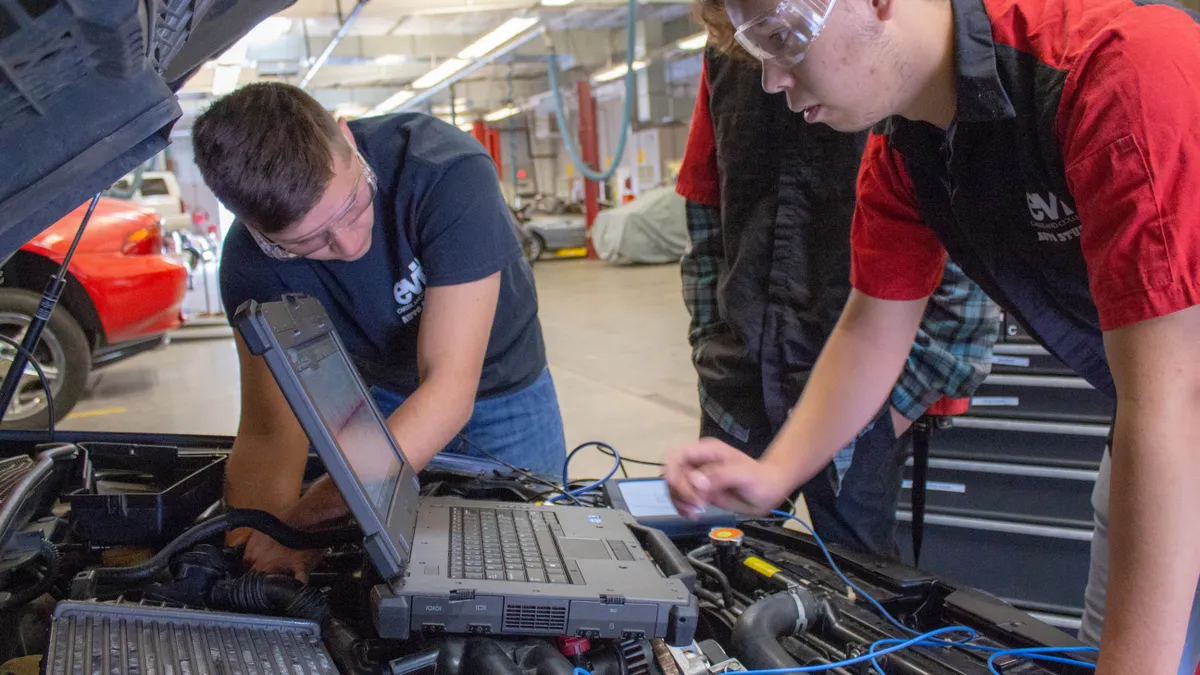When schools suddenly skidded to a halt this spring due to the novel coronavirus pandemic, career and technology educators had to come up with innovative ideas fast.
Much of the curriculum in districts nationwide shifted to a distance learning format, but while online videos can demonstrate proper welding techniques, for example, they are no substitute for handling a welding torch and practicing techniques in real time. Construction, cosmetology, healthcare and culinary arts are no different.
Hands-on professions require in-person practice.
Figuring out blended learning's place in CTE
Chad Wilson, superintendent of East Valley Institute of Technology in Mesa, Arizona — which serves high school students — said his program quickly pivoted by directing students to take care of their reading requirements and prepare for written industry certification tests.
In the meantime, administrators at EVIT worked with educators — many of whom are hands-on industry professionals and aren’t distance-learning-savvy — to bring them up to speed with Zoom class techniques and online technology.
Though the school was in its last quarter, some students still needed to practice their skills and fulfill hands-on requirements in order to earn certifications. The school is now working on bringing small groups of students into the classroom so they can continue hands-on training.
Going forward into an uncertain 2020-21 school year, EVIT is considering implementing “flipped classrooms” that will give students the opportunity to practice skills while in the classroom and learn the academic side of their trades through online content. Flipped classrooms allow students to practice skills or do homework at school with the teacher available to advise, while the lessons are delivered online and assigned as homework.
“If you would have told me in October that we’d be talking about doing a flipped classroom I would have said, ‘Never in a hundred years.’ But here we are,” Wilson said. “We were so focused on kids being here every day, but this forced change allowed us begin to think about how blended learning could work in CTE schools.”
Identifying what can be done, and where
Chelle Travis, executive director of the CTE student organization SkillsUSA, has heard of innovative strategies that ensure students will have a chance to practice skills in-person, even if schools close again. In addition to flipped classrooms, some schools are planning to emphasize hands-on learning curriculum early in the year until the Thanksgiving break. Then — during the flu season, when a spike in coronavirus cases is expected — those CTE schools will turn to a classwork curriculum that can be done at home if schools are forced to close.
Come spring, students would get back to the hands-on part of their learning. “There are things that these students need to know that can be done online,” she said. “They need interview skills, they need to know how to network online.”
The CTE trades are often considered “essential,” Travis said. “Many students affected this spring were able to continue to train with their internships and could continue to get hands-on training. So much of the healthcare training is clinical, for example.”
In Washington, CTE teachers delivered hands-on learning packets to students and checked-out tools. In one district, woodworking students received materials to build their own Adirondack chairs at home. Some students were assigned the task of creating their own building projects, such as a chicken coop mansion. Healthcare students practiced wrapping their siblings’ ankles at home while videoing their techniques.
“In our state, the CTE educators pivoted quickly,” said Rebecca Wallace, executive director of CTE for Washington’s Office of Superintendent of Public Instruction. “In metal shop, students are knocking off the knowledge-based piece until they can get back in to finish their hands-on training.”
She said in some cases, instructors will do tasks live on video, and students will critique them and tell them what they are doing wrong. Culinary instructors are having online competitions similar to the show “Chopped.”
Flipping the career field trip
School shutdowns also halted CTE field trips. So instead of students going to the companies, CareerConnect@Home in Washington state is bringing the employees of those companies to students through daily webinars.
The opportunity, which runs through June 12, is sponsored by Career Connect and developed by Kinetic West, a social impact consulting firm.
Challenge Seattle typically sponsors field trips that bring classes of students to work sites in the Seattle area, where they meet with employers and try a skill, such as making a latte at Starbucks.
“We typically have about 90 [trips] a year,” said Andy Ferrera, Kinetic West consulting manager. “We got through 10 and the rest were canceled.”
Rather than let the whole plan drop, the firm worked with those companies to create career-information webinars. The group focused on uncovering the "invisible" careers.
“Students may not think they could get into carpentry because they aren’t good with a hammer,” said Julia Reed, Kinetic West senior consultant. “But there are other roles in that field that students may not have thought about. There are a lot of roles within one industry.”
Students who love drawing could get into game design, even if they don’t think they can be a programmer, Reed said.
CareerConnect@Home also shows the diverse pathways employees take to get to their destination. “It’s not always the four-year college path,” Ferrera said.
The team also aims to find younger, diverse speakers who reflect the high school student population. Students are invited to ask questions through an Instagram account, which brings out authentic queries such as: Have you ever messed up? What did you learn from your mistake?
The webinars are all recorded and will continue to be available for viewing.
Ultimately, the idea is to show the importance of CTE in the real world, said Maud Daudon, executive leader of Career Connect Washington.
“Career Connect exposes students to many careers and lets them make the connections,” she said. “Students may think they want to be doctors, then realize that they can’t stand the sight of blood. Yet, there are many healthcare careers that don’t require being around blood.”
This is ultimately about exposing students to a variety of career pathways, Ferrera said.
“Lower income students have fewer opportunities,” he said. “We need to make sure we can bring a lot of voices and employees with real jobs to the students.”
Correction: A previous version of this story misidentified the superintendent of East Valley Institute of Technology, Chad Wilson.




















